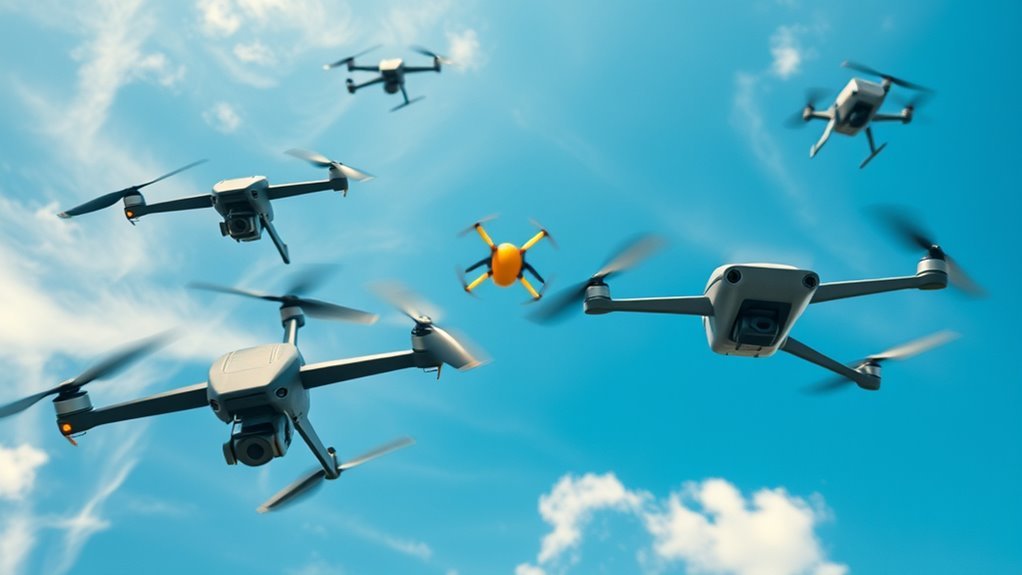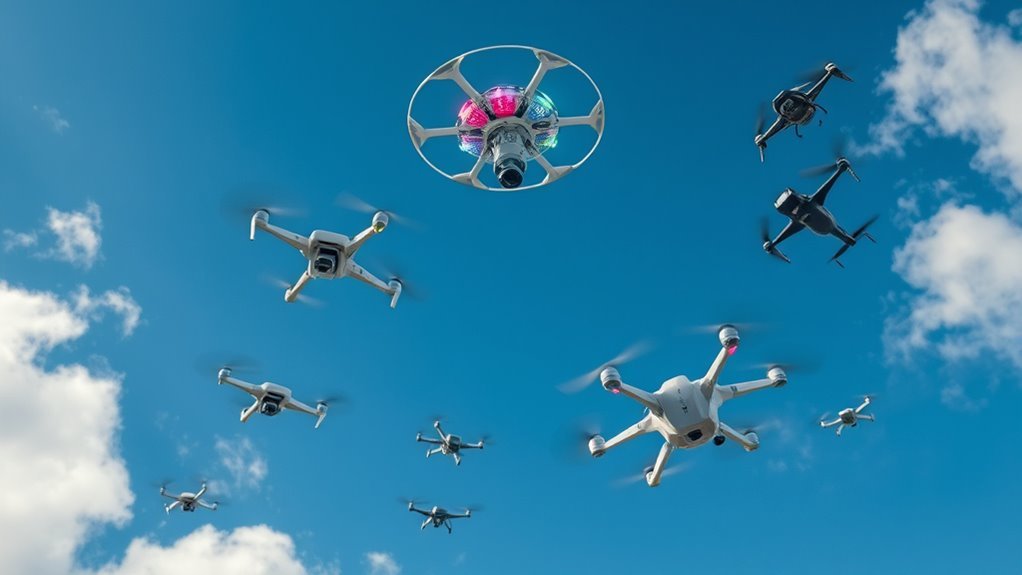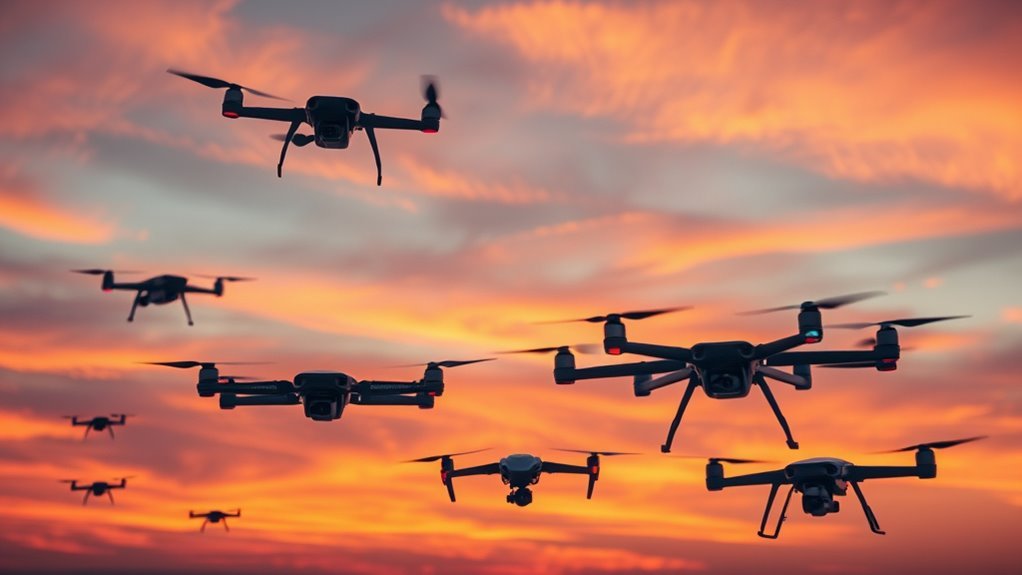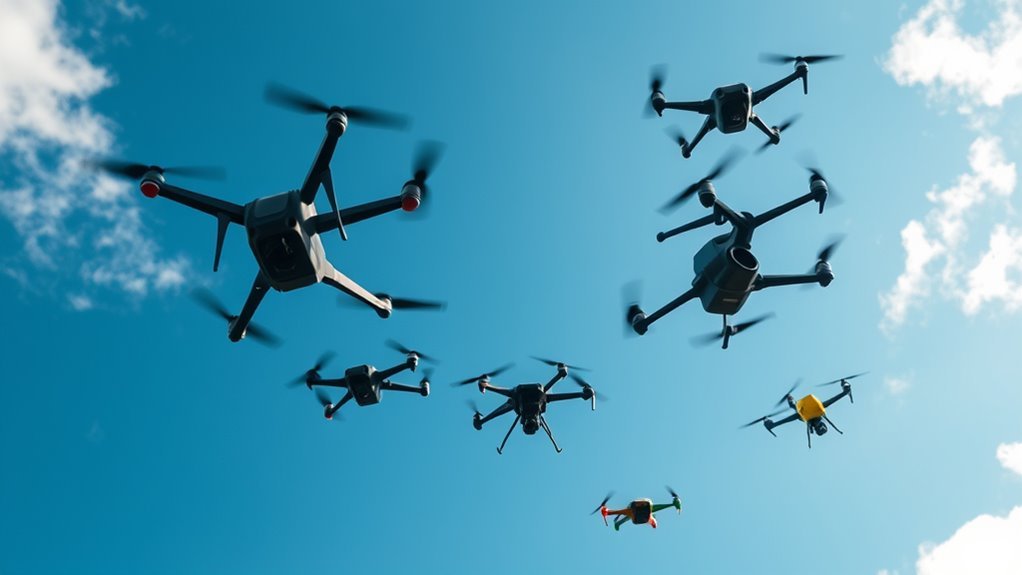Drones exhibit a fascinating variety of shapes and sizes in the sky. Compact quadcopters feature sleek lines for urban maneuverability, while fixed-wing models boast aerodynamic designs for longer flights. Specialty drones, like agricultural or delivery drones, have unique aesthetics tied to their functions. Military drones prioritize stealth and functionality, often appearing more rugged. The blend of color and material enhances visibility and performance. If you’re curious about how these designs impact their usage, there’s much more to explore.
The Evolution of Drone Design

As drone technology has advanced, the design of these flying machines has dramatically evolved to meet diverse needs and applications. You’ll notice that contemporary drones come in various shapes and sizes, reflecting innovative design trends that cater to both recreational and commercial uses. From sleek, compact models for personal use to robust, multi-rotor drones built for industrial tasks, each design serves a specific purpose. The materials have shifted as well, with lightweight composites enhancing durability and flight efficiency. Additionally, modular designs are becoming popular, allowing you to customize your drone for different missions. As you explore these advancements, you’ll appreciate how they empower you to harness the freedom of flight, no matter your goals. Furthermore, the advanced AI integration in drones like the Lucid Cleaning Drone exemplifies how technology enhances operational capabilities. Moreover, the core features for NDAA adherence in some drones ensure they can operate securely in sensitive environments, underscoring the importance of compliance in modern drone design.
Compact Quadcopter Aesthetics

When it comes to compact quadcopters, aesthetics play an essential role in both design and functionality. You’ll notice a variety of design features and color schemes that not only enhance visual appeal but also impact performance. Understanding propeller configurations can further reveal how these drones are engineered for peak efficiency while maintaining a sleek appearance. For instance, the modular design of drones like the Freefly Alta 8 allows for customization that enhances both form and function, reflecting the importance of adaptability in drone engineering. Additionally, features like obstacle avoidance technology ensure that even with their compact forms, these drones can navigate their environments safely and efficiently.
Design Features and Variations
Compact quadcopters have revolutionized the drone design landscape, showcasing a variety of aesthetics that merge functionality with visual appeal. These drones often prioritize sleek lines and compact structures, making them ideal for urban environments. With advancements in camera integration and battery technology, they balance performance and design effortlessly.
Here’s a quick look at some key design features:
| Feature | Description | Impact on Performance |
|---|---|---|
| Sleek Frame | Lightweight materials | Enhances maneuverability |
| Integrated Cameras | High-resolution options | Improves image quality |
| Efficient Batteries | Longer flight times | Extends operational range |
As you explore compact quadcopters, consider how these design features contribute to their overall effectiveness and appeal.
Color Schemes and Patterns
The aesthetic appeal of compact quadcopters extends beyond their sleek frames and functional designs; color schemes and patterns play a significant role in attracting users and enhancing the overall experience. Understanding color psychology and pattern significance can elevate your flying experience. Here are three key aspects to evaluate:
- Color Choice: Bright colors like red or yellow can improve visibility, while darker shades may blend into the background, affecting your drone’s discoverability.
- Pattern Variation: Unique patterns can signify the drone’s capabilities or brand identity, helping users choose the right model for their needs.
- Personal Expression: Custom colors and designs allow you to express your personality, making your quadcopter a reflection of your individual style in the sky.
Propeller Configurations Explained
While many enthusiasts focus on aesthetics and color when selecting a compact quadcopter, propeller configurations are equally crucial in determining performance and maneuverability. Different propeller types, such as standard, tri-blade, or even coaxial, influence your drone’s rotor efficiency and overall flight characteristics. For instance, tri-blade propellers may offer better lift and stability, while standard two-blade designs can enhance speed and agility. Understanding how these configurations affect thrust helps you tailor your quadcopter to your flying style. Additionally, the pitch of the propellers can greatly impact acceleration and climbing capabilities. By selecting the right propeller setup, you can release your drone’s full potential, enabling you to explore the skies with unparalleled freedom and confidence.
Fixed-Wing Models: Sleek and Streamlined

When it comes to fixed-wing drones, their aerodynamic design is key to enhancing flight performance. These models are engineered for efficiency, allowing for longer flight times and greater distances. You’ll find that their sleek and streamlined shapes greatly reduce drag, making them ideal for a variety of applications. Additionally, fixed-wing configuration drones like the Delair UX11 AG can achieve impressive altitudes, further expanding their operational capabilities. The Wingtra One is another excellent example of a fixed-wing drone that emphasizes durability and precision, making it suitable for demanding surveying tasks.
Aerodynamic Design Features
Understanding the aerodynamic design features of fixed-wing drone models is essential for optimizing their performance. You’ll find that effective drone aerodynamics greatly enhances design efficiency, allowing for smoother flights. Here are three key features to take into account:
- Wing Shape: The shape of the wings, whether tapered or straight, impacts lift and drag, influencing speed and stability.
- Fuselage Design: A streamlined fuselage minimizes air resistance, enhancing overall efficiency and allowing longer flight times.
- Control Surfaces: Ailerons and elevators on wings and tails provide critical maneuverability, enabling precise handling during various flight conditions.
These features work together to guarantee your fixed-wing drone not only flies effectively but also achieves its intended purpose with freedom and precision in the skies.
Flight Performance Capabilities
As you explore the flight performance capabilities of fixed-wing drone models, you’ll quickly notice their sleek and streamlined design greatly contributes to their efficiency in the air. These drones excel in maintaining flight stability, allowing for smooth navigation even in varying wind conditions. Their aerodynamic shape reduces drag, which enhances battery efficiency and enables longer flight durations. This means you can cover more ground without frequent recharges, giving you the freedom to conduct extensive aerial surveys or enjoy leisurely flights. Additionally, fixed-wing drones can achieve higher speeds compared to multi-rotor models, making them ideal for rapid data collection or extended range missions. Embracing the advanced technology behind these drones opens up a world of possibilities for your aerial adventures.
Specialty Drones for Unique Tasks
While many drones serve general purposes, specialty drones have emerged to tackle unique tasks across various industries. These innovations cater to specific needs, enhancing efficiency and effectiveness. Here are three examples of specialty drones you might find intriguing:
- Agricultural Drones: Designed for crop monitoring, these drones analyze soil health and assess crop conditions, enabling farmers to make data-driven decisions. They often utilize advanced monitoring technologies to detect pests and diseases in real time, ensuring timely interventions.
- Delivery Drones: Ideal for logistics, these drones transport goods quickly and efficiently, reducing delivery times and expanding reach in urban areas.
- Surveying Drones: Equipped with high-resolution cameras, these drones conduct aerial surveys, providing precise data for construction, mining, and environmental studies.
Additionally, crop geofencing capabilities in agricultural drones ensure precise operational boundaries, enhancing safety and effectiveness during farming tasks.
With these specialty drones, you’re witnessing the future of technology, revealing new possibilities across various fields.
The Role of Color and Material in Drone Appearance
Drones come in a variety of colors and materials, each choice impacting not just aesthetics but also functionality. Color psychology plays a key role here; bright colors can enhance visibility, making drones easier to spot during flight, while darker hues may be preferred for stealthy operations. Additionally, the material used in drone construction affects durability. Lightweight composites can improve performance, but metals may offer superior strength in rugged conditions. You’ll find that a drone’s appearance isn’t just about looks—it’s about how well it performs in the field. By understanding the significance of color and material, you can choose a drone that aligns with your specific needs, whether that’s for recreation or more serious applications. Furthermore, Autel’s advanced sensors are designed for precise obstacle avoidance, which can be further influenced by the drone’s visual design and color choices in various operational environments. The compact and foldable design of many drones, like the Dji Mavic Pro, also plays a crucial role in their portability and ease of use during travel.
Military Drones: Stealth and Functionality
Military drones have revolutionized modern warfare, blending stealth with advanced functionality. These aerial machines offer unparalleled advantages on the battlefield. Here are a few key features that enhance their effectiveness:
- Surveillance Capabilities: Equipped with high-resolution cameras and sensors, military drones gather real-time intelligence, monitoring enemy movements without detection.
- Combat Applications: Certain drone variants can engage in precision strikes, delivering munitions with pinpoint accuracy while minimizing collateral damage.
- Stealth Technology: Incorporating radar-absorbing materials and low-noise engines, these drones evade enemy radar and anti-aircraft systems, ensuring they can operate undetected.
With their unique design and multifunctional roles, military drones represent a new era in defense, prioritizing both effectiveness and the preservation of freedom.
Drones With Payload Capacity: Bulk and Structure
When it comes to payload capacity, the design and structure of drones play a critical role in their operational capabilities. You’ll find that maximizing payload optimization is essential for various applications, from logistics to surveillance. Drones designed with a robust framework guarantee structural integrity, allowing them to carry heavier loads without compromising performance. The materials used, like carbon fiber or aluminum, contribute markedly to weight reduction while enhancing strength. Additionally, the configuration of the motors and propellers must align with the drone’s weight to maintain stability and control. By understanding these elements, you can appreciate how advanced engineering transforms drones into powerful tools capable of lifting substantial payloads while maneuvering diverse environments with agility and precision. Furthermore, compliance with FAA regulations ensures that these drones can operate safely and legally in various settings. Moreover, the potential US ban on DJI may drive market innovation as competing brands seek to develop more efficient designs to meet emerging consumer needs.
Personal and Recreational Drones: Fun Shapes and Styles
Personal and recreational drones come in a myriad of shapes and styles, each designed to cater to different tastes and preferences. You can explore custom designs that reflect your personality while enjoying unique features that enhance your flying experience. Here are three popular styles:
- Racing Drones: Sleek and aerodynamic, these are built for speed and agility, perfect for competitive flying.
- Camera Drones: Often featuring gimbal stabilization, these drones offer high-quality aerial photography and videography capabilities, such as those found in the E88 Pro 4k Drone.
- Toy Drones: Compact and colorful, these lightweight models are ideal for beginners and casual flyers, often equipped with fun LED lights.
Additionally, many camera drones, including the Dji Mini Drone 3, boast advanced video stabilization features that minimize shake and jitter for smoother footage. With such a variety, you can easily find a drone that resonates with your spirit of freedom and adventure!
The Future of Drone Design and Aesthetics
As technology evolves, so does the landscape of drone design and aesthetics. Imagine a future where drones are not just functional but also visually enchanting. With design innovations, drones will adapt to your needs, whether it’s for delivery, surveillance, or recreation. You’ll see streamlined shapes that enhance aerodynamics, making them faster and quieter, perfect for urban environments. These drones could also feature customizable exteriors, allowing you to express your personality or brand. Future functions might include advanced AI, enabling them to navigate complex environments seamlessly. Additionally, many drones will incorporate advanced camera capabilities, ensuring high-quality visual content while flying. As we embrace these advancements, the aesthetic appeal of drones will become as important as their capabilities, merging utility with artistry in the skies. Get ready for a future where freedom and design go hand in hand! Additionally, advancements in AI-driven choreography will allow drones to perform synchronized aerial displays, elevating their visual impact during events.
Frequently Asked Questions
How Do Weather Conditions Affect Drone Appearance in the Sky?
Weather effects greatly influence drone visibility conditions. Fog, rain, or heavy winds can obscure your drone’s appearance, while clear skies enhance its visibility. Understanding these factors guarantees safer, more efficient flight operations in varying weather scenarios.
Can Drone Shapes Impact Their Flight Performance?
Yes, drone shapes greatly impact flight performance. You’ll notice that optimized shapes enhance aerodynamics, improving shape efficiency. A well-designed drone can maneuver better, conserve energy, and ultimately provide you with greater freedom in the skies.
What Materials Are Commonly Used in Drone Construction?
When it comes to drone construction, you can’t judge a book by its cover. Common materials include carbon fiber, plastic composites, and metal alloys, all designed for lightweight structures while ensuring aerodynamic efficiency and structural integrity.
How Do Different Drone Sizes Influence Visibility at Distance?
Different drone sizes greatly affect drone visibility and distance perception. Smaller drones may blend into the background, while larger ones stand out more. Understanding this helps you gauge their presence effectively during your aerial activities.
Are There Regulations Regarding Drone Shapes and Sizes?
Ever wondered why drone design matters? Flight regulations often dictate shapes and sizes for safety and airspace management. Understanding these rules helps you navigate the skies responsibly while enjoying your drone-flying freedom.

